Consumers are becoming more aware—and more concerned—about what goes into their everyday products. From dishwashing liquids to personal care and laundry solutions, traditional petrochemical-based surfactants dominate the market. But these ingredients come at a cost: skin irritation, water pollution, and long-term ecological harm. Even worse, they often fail to solve consumer pain points, with chemical residues, poor biodegradability, and limited transparency around sourcing and safety.
Conventional formulations, rooted in fossil-based chemistry, are increasingly out of sync with today’s sustainability goals. As industries face rising pressure to reduce toxicity, meet green regulations, and appeal to eco-aware customers, bio-surfactants are emerging as the future-ready alternative. Today, a sustainable revolution is rising with bio-surfactants — natural, renewable, and far safer alternatives that promise the same performance without pollution. But to understand how impactful this shift is, let’s revisit the consumer challenges from the “old age” of petrochemical dominance.
But how do companies know where to innovate next? In this blog, we uncover how Technology Gap Analysis is empowering brands to identify missing pieces in surfactant innovation—from microbe-derived ingredients to non-toxic foaming agents and biodegradable emulsifiers—shaping products that are cleaner, safer, and aligned with global sustainability goals.
The Old-Age Problems We All Faced
- Toxicity: Conventional surfactants made cleaning easier—but at the cost of skin irritation, environmental poisoning, and long-term aquatic toxicity.
- Bioaccumulation: These molecules stuck around—lingering in water bodies, soils, and even food chains.
- Wastewater Trouble: Traditional surfactants were hard to degrade, weakening even the microorganisms meant to treat our water.
- Carbon Footprint: They relied on finite fossil fuels, intensifying CO₂ emissions and leaving a heavy sustainability debt.
And in the age of climate consciousness, such costs are no longer acceptable—pushing industries to urgently seek safer, sustainable alternatives that align with consumer expectations and stricter environmental regulations.
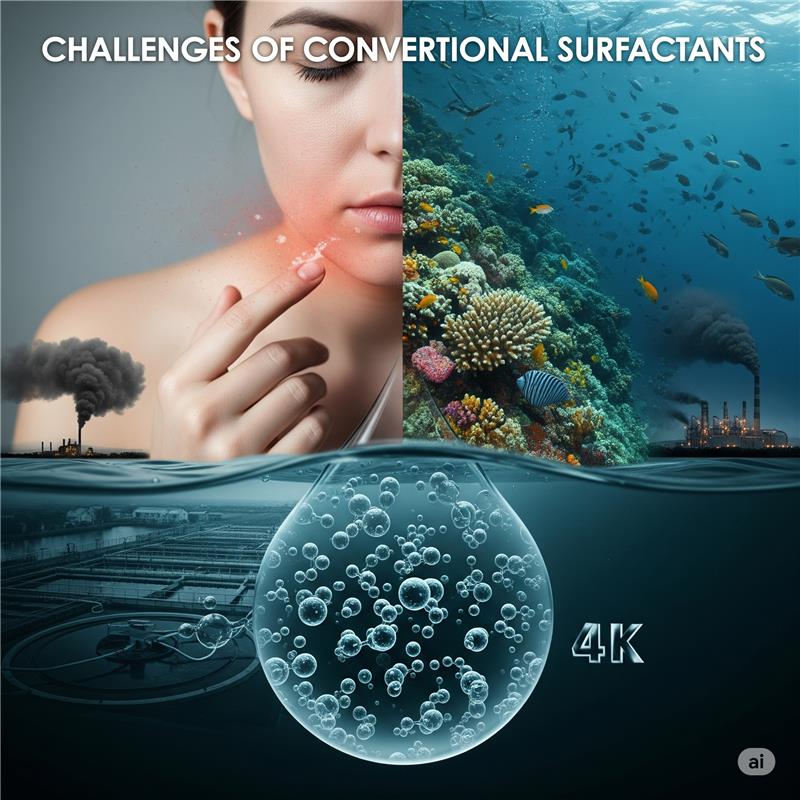
What are bio-surfactants, and why are they gaining attention?
Bio-surfactants are eco-friendly, biodegradable surface-active compounds produced by microorganisms or extracted from plant-based sources. Unlike traditional petrochemical surfactants, they are non-toxic and sustainable, making them safer for both humans and the environment. At this intersection of nature and science, technology scouting plays a vital role—helping businesses identify cutting-edge strains, feedstocks, and processes to optimize bio-surfactant development.
Their exceptional cleaning, foaming, and emulsifying abilities make them ideal for applications in personal care, household products, and industrial processes. As consumers and industries prioritize green solutions, bio-surfactants are rapidly gaining popularity for enabling high performance without compromising environmental safety.
Each year Signicent provides consultancy to hundreds of organizations to help transform their innovations to value.
How Bio-surfactants Work Just Like Petrochemical Surfactants
Bio-surfactants are amphiphilic molecules—just like synthetic ones—meaning they possess both hydrophilic (water-attracting) and lipophilic (oil-attracting) parts. This unique structure enables them to emulsify oils, generate foam, cleanse surfaces, and suspend particles—delivering all the essential functions consumers expect in modern products.
But what truly sets them apart is their origin and environmental footprint.
Below, you’ll find a feature-by-feature comparison highlighting how bio-surfactants outperform petrochemical surfactants across key product categories:
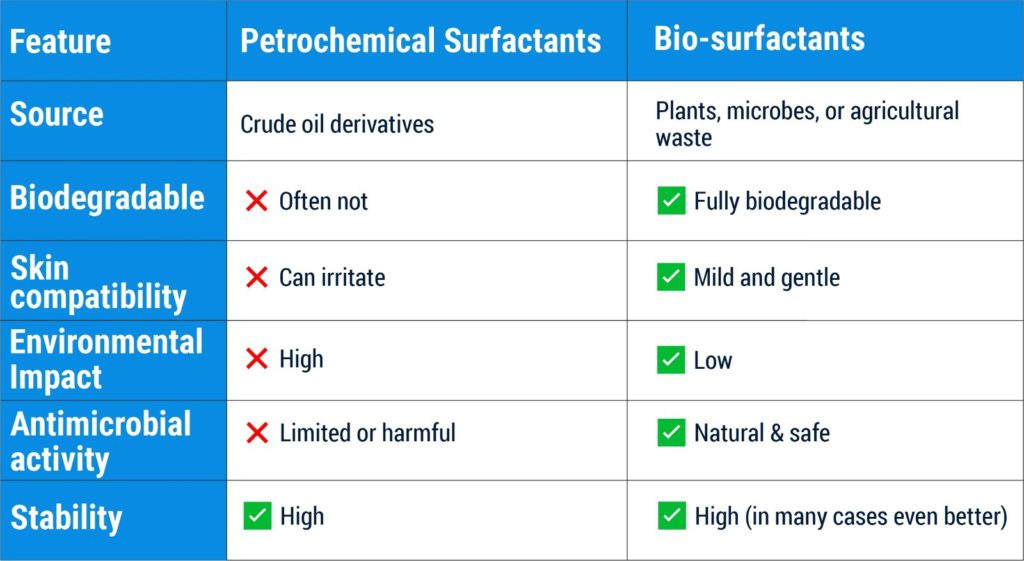
Benefits of Using Bio-surfactant-Based Products
As consumer demand shifts toward cleaner, safer, and planet-friendly solutions, bio-surfactants are emerging as a go-to ingredient in next-generation formulations. Companies across industries are rethinking their formulations to meet rising expectations around health, sustainability, and performance.
Here’s why bio-surfactants are gaining ground:
- Consumer-Safe & Skin-Friendly
Gentle on skin and eyes, bio-surfactants reduce the risk of irritation—making them ideal for personal care, baby care, and household products. - Eco-Conscious & Biodegradable
Derived from renewable sources and fully biodegradable, these surfactants minimize long-term environmental impact. - Effective Performance, Naturally
Offers excellent foaming, emulsifying, and cleansing properties—without relying on harsh chemicals. - Meets Clean Label Expectations
Aligns with the clean beauty and green cleaning movement, offering transparency and trust for label-conscious customers. - Regulatory & Brand Advantage
Helps brands stay ahead of evolving safety regulations while enhancing eco-credentials and consumer loyalty.
Old Age Problems Faced by Consumers Due to Traditional Petrochemical Surfactants:
- Skin and Respiratory Irritation: Petrochemical surfactants often caused allergic reactions, rashes, and breathing issues due to their synthetic origin and residues.
- Toxic Wastewater Discharge: After cleaning, surfactants don’t just disappear. They entered water bodies, harming aquatic life and entering the human food chain.
- Non-biodegradable Packaging & Residues: Persistent chemicals in products meant that their residues lingered on fabrics, skin, and in the environment.
- Antimicrobial Resistance: Constant exposure to harsh chemicals weakened the effectiveness of natural bacteria and encouraged resistant strains.
- Harsh Formulations: Many cleaning and personal care products included powerful but harmful compounds that were too aggressive for sensitive skin and household surfaces.
- Poor Wastewater Treatment Efficiency: Surfactants remained intact through treatment processes, polluting rivers and reducing the effectiveness of microbial remediation systems.
- Lack of Circularity: Traditional surfactants were derived from fossil fuels, with production processes that were energy-intensive and carbon-heavy.
The New-Age Solution: Bio-Surfactants
Bio-surfactants step in as the smarter, safer upgrade our products—and our planet—truly need, offering a sustainably synthesized alternative to outdated, petrochemical-based ingredients. These natural surface-active agents, derived from plants, microbes, and agro-waste, don’t just compete with petrochemical surfactants—they outperform them in many ways.
Let’s compare the shift:
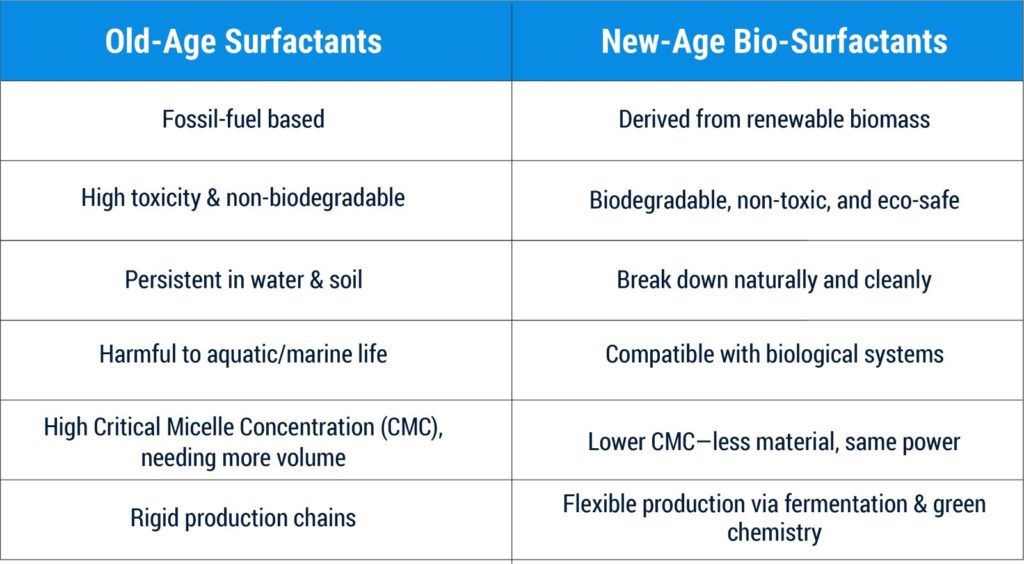
Innovative Methods to Stop Petrochemical Surfactant Use
Modern innovators are reimagining surfactants from the ground up—transforming everything from feedstock to formulation to replace petroleum-based ingredients with sustainable, green chemistry alternatives.
Here’s how innovation is leading the way:
- Agro-Waste Valorization: Why rely on fresh crops when we can upcycle what’s already wasted? Innovations are now converting molasses, potato peels, corn husks, and even fruit pulp into low-cost feedstock for microbes. This circular approach not only cuts waste but significantly reduces production costs.

- Microbial Engineering: Genetically modified bacteria like Pseudomonas and yeasts like Candida bombicola produce biosurfactants (rhamnolipids and sophorolipids) in controlled bioreactors.
- Fermentation Optimization: Through precise control of pH, temperature, and nutrient balance, companies are now optimizing fermentation conditions to maximize biosurfactant yields. This means higher output, lower costs, and more efficient production—turning microbes into mini bio-factories.
- Enzyme Catalysis: Enzymes enable low-energy production routes for bio-based surfactants — reducing heat, pressure, and chemicals in synthesis.
- Green Formulation Standards: Cosmetic and personal care brands are adopting EcoCert, COSMOS, and USDA Organic standards, driving demand for natural surfactants.
- Tech-Enabled Strain Engineering: Advanced synthetic biology and CRISPR are empowering scientists to design microbial strains—like genetically optimized Pseudomonas or Candida species—that produce higher quantities of high-purity bio-surfactants. These engineered strains offer better stability, faster growth, and higher yields—making industrial-scale production more practical than ever.
- First & Second-Generation Bio-surfactants: From chemically extracted plant-based surfactants (like saponins and APGs) to microbially synthesized biosurfactants, the product library is expanding fast.
These innovations not only safeguard the planet—they also promote healthier lifestyles, safer daily-use products, and meet rising consumer demand for clean, sustainable, and skin-friendly alternatives.
How Bio-Surfactants Are Powering Everyday Products
Bio-surfactants like rhamnolipids, sophorolipids, and APGs are already creating waves—powering safe, sustainable innovation across personal care, home care, and industrial applications. As these natural solutions go mainstream, it’s critical for businesses to ensure Freedom to Operate (FTO)—so they can commercialize without legal risks or IP roadblocks. That’s where Signicent helps, enabling clients to bring innovations to the market with clarity and confidence.
And below, you can see how these powerful bio-solutions are making a difference across key product categories—reshaping the way we clean, care, and manufacture sustainably:
- Cosmetics & Personal Care – Because your skin deserves better, these gentle cleansers clean deeply without harsh effects.
- Agrochemicals – Helping farmers grow safer food with natural agents that care for crops and the earth.
- Food – Supporting cleaner labels with natural emulsifiers that keep food stable—and families worry-free.
- Oil & Mining – Making tough industries greener, bio-surfactants clean soils and boost oil yield the smart way.
- Home Care & Cleaning – From kitchens to laundry, these solutions clean powerfully—without harming your hands or home.
Their built-in antimicrobial, antiviral, and anti-inflammatory properties make them truly multifunctional.
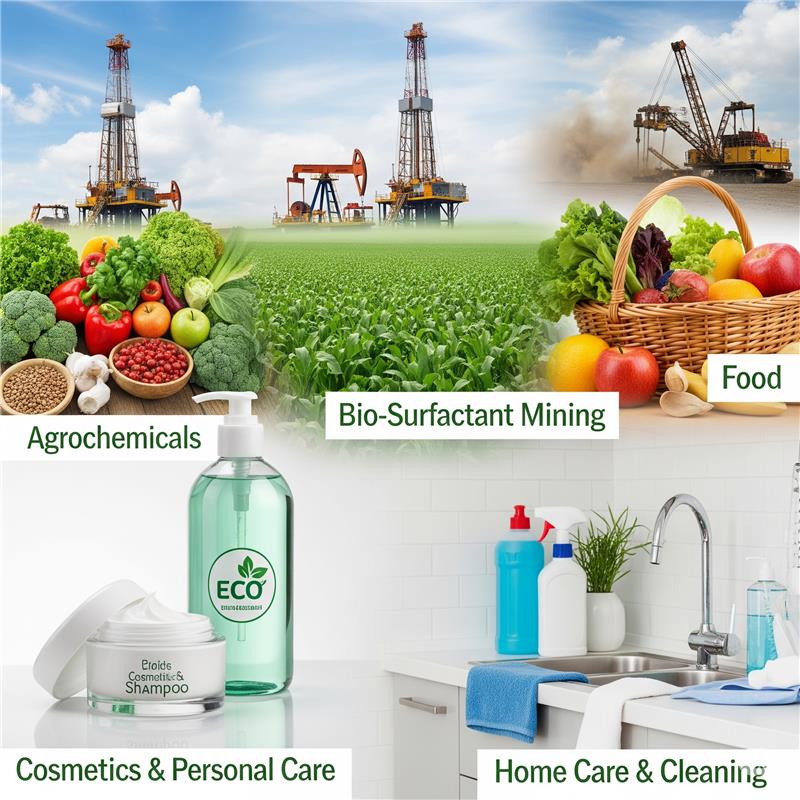
Key Consumer Benefits of Bio-surfactants
Today’s conscious consumers seek more than just cleaning power—they want safety, sustainability, and trust. Bio-surfactants meet that need, protecting people, pets, and the planet effortlessly.
- Gentle on Skin, Safe for Kids & Pets: Naturally mild and irritation-free—perfect for sensitive skin, babies, and your furry companions.
- Eco-Friendly Cleaning: Powerful cleansing without polluting rivers—clean your space while caring for the environment.
- Natural Preservative Effects: Built-in antimicrobial benefits keep products fresher longer—without harsh chemical additives or toxins.
- Better Biodegradation: Breaks down safely in soil and water—leaving behind zero harmful residues or pollutants.
- Effective Even in Hard Water: Performs well across water types—no compromise in cleaning power or product consistency.
- Low Foam Options for Modern Machines: Designed for low-suds efficiency—perfect for front-load washers and eco-conscious cleaning routines.
How Top Brands Are Putting Consumers First with Safer, Greener Bio-Surfactant Solutions
- Evonik Industries – A pioneer in sophorolipid production, Evonik’s REWOFERM® range offers biosurfactants for dishwashing and laundry applications. They emphasize mildness, foam control, and renewable carbon content.
- Ecover/Method (SC Johnson) – These brands are now using plant-based surfactants in most of their household cleaners, offering clear labeling and full biodegradability to consumers.
- Solvay – Their Mirasoft® line of glycolipid biosurfactants, used in personal care and cosmetics, replaces harsh sulfates and PEGs with naturally derived options.
- L’Oréal – Invested in green chemistry R&D, replacing petro-surfactants in skincare and shampoo formulations to address sensitive skin consumer segments.
- BASF – Introduced Dehyton® and Lamesoft® bio-based surfactants to meet eco-labeling criteria across Europe, used widely in baby care and dermatology products.
Market Outlook for Bio-Surfactants
The bio-surfactants market is gaining significant traction as industries pivot toward safer, greener formulations. With rising awareness around chemical toxicity, demand for naturally derived, biodegradable alternatives is accelerating across personal care, home care, food, and industrial cleaning sectors.
According to Signicent Market Research, global adoption of bio-surfactants is steadily growing as companies align with clean-label trends, ESG commitments, and evolving green certification standards.
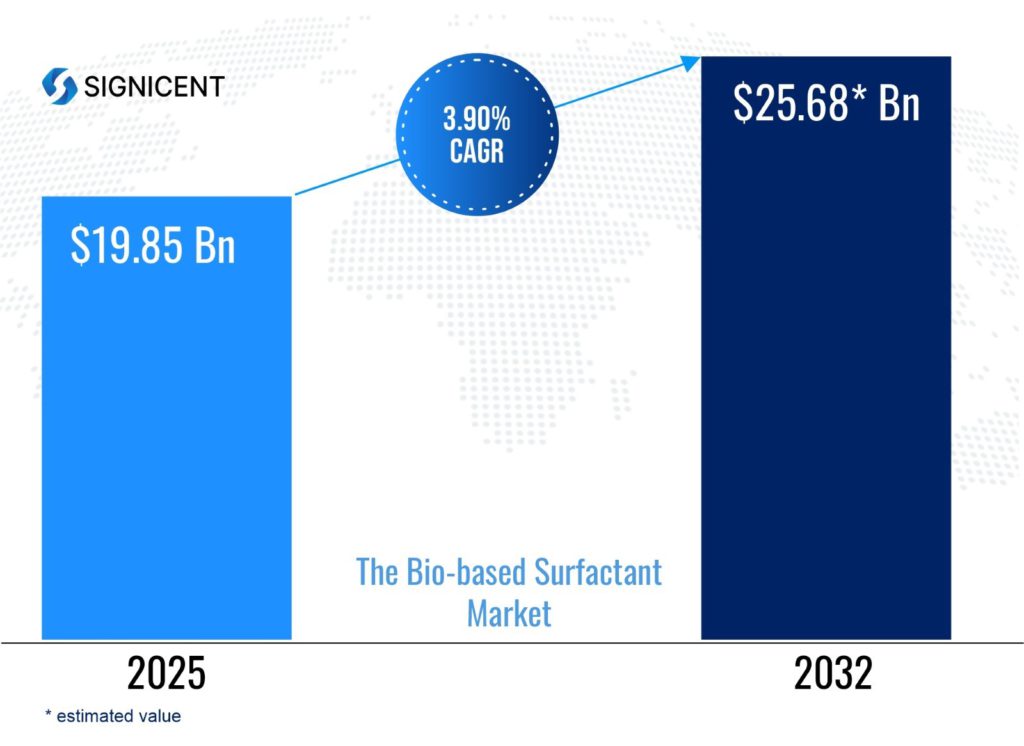
Growth Drivers:
- Shift toward sustainable, non-toxic formulations
- Rising demand for natural and organic personal care products
- Advancements in microbial fermentation and enzyme technology
Commercial and Regulatory Challenges in Scaling Bio-Surfactants:
- Higher production and purification costs
- Consistency and scale-up variability
- Need for standardized definitions of “natural” ingredients
As technology advances and economies of scale unfold, bio-surfactants are not just poised to overtake synthetics—they’re redefining what safer, cleaner, and socially responsible products should look like.
Key Players Leading the Bio-surfactant Revolution
These leaders are not only formulating alternatives but also educating consumers and helping industries meet green mandates.
Signicent’s Contribution: Powering the Bio-Surfactant Revolution
Recently, Signicent supported a client in replacing petrochemical surfactants with next-gen bio-surfactants by uncovering breakthrough ingredients, microbial strains, and enzyme pathways through deep technology scouting and market research.
Our comprehensive approach included IP landscaping and Patent Landscape Analysis to spot innovation clusters, understand emerging trends, and guide R&D with clarity. This was complemented by competitor benchmarking to reveal formulation gaps, and material mapping to identify renewable, low-impact feedstocks like agro-waste and plant sugars.
We also performed white space analysis to align with market needs—such as sulfate-free claims, sensitive skin applications, and green label certifications—while unlocking opportunities in personal care, home cleaning, and industrial degreasing.
Whether you’re optimizing bioprocess scalability, navigating shifting regulations, or seeking your next sustainable breakthrough—Signicent is your strategic partner in innovation.
Together, let’s accelerate your transition to safer, greener surfactant technologies—with actionable insights, deep domain expertise, and a roadmap tailored to your business goals.
Conclusion: From Petroleum to Plants — A Cleaner Future for All
The shift from petrochemical to bio-surfactants is no longer an eco-conscious experiment — it’s the new standard for responsible innovation. What once relied on harsh synthetics is now evolving through green chemistry, microbial precision, and circular thinking to meet the demands of today’s health-conscious, planet-focused consumers.
At Signicent, we’ve seen firsthand how brands are embracing this change — scouting sustainable feedstocks, unlocking microbial pathways, and reengineering formulations that deliver performance with purpose. Challenges around scalability, cost, and consistency remain — but so does the determination to build better.
With ongoing research, strong industry support, and growing consumer awareness, the future of surfactants is natural, sustainable, and smart. It’s time for companies, regulators, and consumers to walk together toward a greener, healthier world — and bio-surfactants are leading the way.
About Signicent LLP
We assist businesses globally in their technology innovations, R&D, new product development, patents, valuation, product commercialization & market research needs.
Services Offered:
- Patent Landscape
- Patent Portfolio Analysis
- Patent Invalidity Search
- Patent Licensing Services
- Freedom to operate (FTO)
- Chemical Structure Search
- Design Patent Search
- Technology Scouting
- Technology Landscape Analysis
- Technology gap analysis
- Technology Intelligence
- Market Research
- Bio Sequence Search
Elevate your Innovation and Research with Signicent’s cutting-edge approach to assist you with Technology and Market related matters alongside the IP aspect of the analysis.


